Dragonfruit for Breakfast
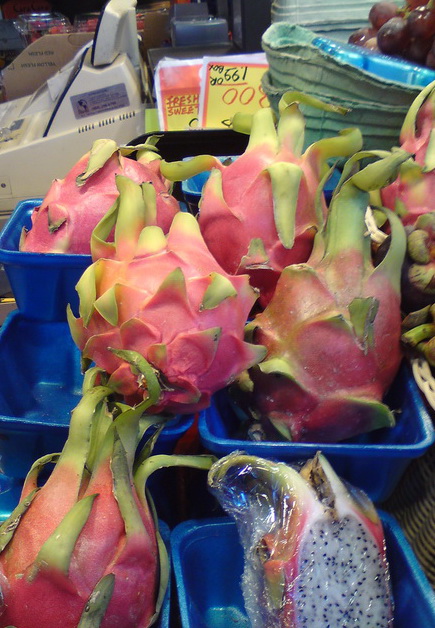 My body is convinced I’ve lost the plot. They tell me that’s what happens with jetlag, but I really think that it might be more than that at this stage – I suspect a revolt is imminent. The barefoot mountain guide & I got back from a two week visit to Canadia (yes, that’s right – Canadia. So that “Canadian” makes more sense) last week and we’re still hovering somewhere over the Rockies time-wise. It’s a real problem for a non-morning person to suddenly be wide awake at 4am or earlier, and literally falling asleep on my feet by 6pm! My whole life schedule is in doubt and I think it might lead to an existential crisis soon – something my last team of angelic brand managers found peculiar and highly amusing just before I left corporate last year. But look at how big an impact that one had on my life! I’m not sure I can afford another at this stage…
My body is convinced I’ve lost the plot. They tell me that’s what happens with jetlag, but I really think that it might be more than that at this stage – I suspect a revolt is imminent. The barefoot mountain guide & I got back from a two week visit to Canadia (yes, that’s right – Canadia. So that “Canadian” makes more sense) last week and we’re still hovering somewhere over the Rockies time-wise. It’s a real problem for a non-morning person to suddenly be wide awake at 4am or earlier, and literally falling asleep on my feet by 6pm! My whole life schedule is in doubt and I think it might lead to an existential crisis soon – something my last team of angelic brand managers found peculiar and highly amusing just before I left corporate last year. But look at how big an impact that one had on my life! I’m not sure I can afford another at this stage…
Anyway, back to Canadia. So much happens in a two week holiday that it’s always difficult to cut through all the noise and find the interesting stuff – the equivalent of finding the photos that are actually good as opposed to just bombarding your friends to death with happy holiday snaps.
First thing, it’s far away. Really far. And from little old South Africa, there is no short cut unfortunately. So we had a lot of time on planes, buses, cars, ferrys, in airports, and waiting in queues (that’s line-ups in Canadian-speak). And as for the jet lag thing, the less said the better. Next time I’m going west, and I’ll be carrying on west until I get home again. Even if I have to take a ferry all the way round.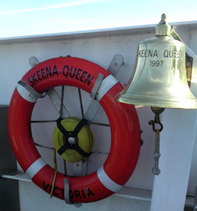
Second thing, it’s cold. Yes, I know it’s not called the “great white north” for nothing, and also it is quite far north of here, but still. Everyone said Vancouver in the Springtime was both the most beautiful city in Canadia, and the one with the most temperate climate. And I guess that’s true relative to the ice-ridden plains further north but for little old South African me, it was freezing! Seriously, when we left Cape Town it was sunny and 20C in Winter (one of those hidden winter days that Capetonians don’t tell anyone else about), and when we got to Vancouver it was partly cloudy with a watery sunshine and 16C and everyone was rejoicing about the beautiful weather. Right.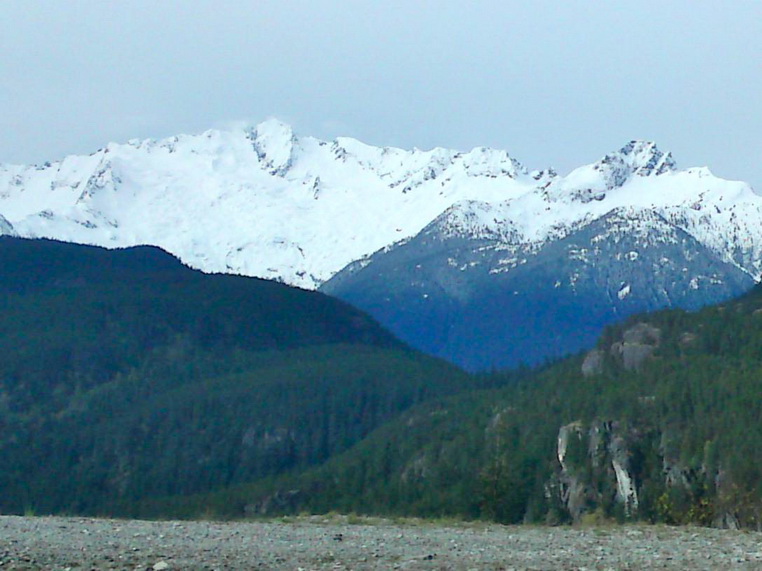 Third thing, it really is beautiful. Serious “picture postcard” beautiful scenery in every possible direction – snow covered Rockies guarding the city; picturesque riverside houses (some that float, even!), and dramatic fir tree forest draped islands drifting off the coast in the deep, cold waters of the Pacific.
Third thing, it really is beautiful. Serious “picture postcard” beautiful scenery in every possible direction – snow covered Rockies guarding the city; picturesque riverside houses (some that float, even!), and dramatic fir tree forest draped islands drifting off the coast in the deep, cold waters of the Pacific.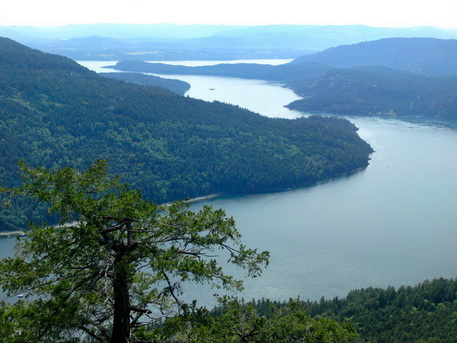
But really, more interesting than any of this is how similar and how very different Canadia and South Africa are.
On the similar side, I could easily see how many South Africans have been able to adapt to living in Canadia despite the cold climate.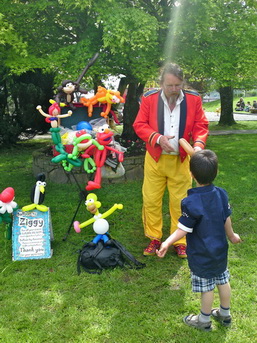
The people are lovely. The Canadians I met were warm, friendly and down-to-earth, just like most South Africans. And they have a great sense of humour, again much like Saffers. I guess they need it to have survived winters out there. Also, no offence to any Americans reading, but Canadians seemed on the whole to me much more demure than the generalization of American loudness. A trait which could only endear them to us!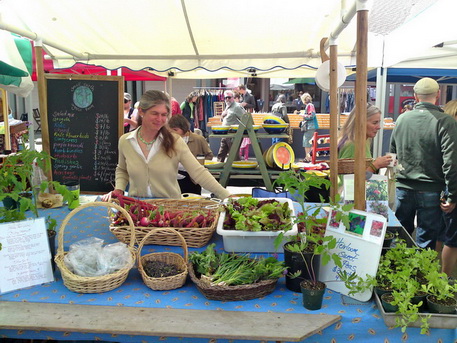
The coffee and the food are fabulous. There are a fair number of wonderful food and produce markets around, leaving no excuses for eating poorly or living on MacDonalds and co.
My resident coffee-snob (and his equally coffee-inspired mom, I discovered!) would say that South Africans don’t really know much about real coffee, and having worked on the category for a while I would have to agree. But, things are changing and as uneducated as our coffee palates are, we know a good Mocha (pronounced Mow-ka) when we taste it! I’m not sure the fabulous food and Mocha’s would be great for South African waist-lines, but then again, North America has already moved onto a whole new standard of “normal” on that score.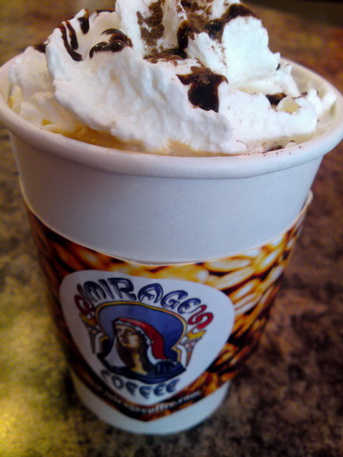
The coffee-snob barefoot mountain guide and I had noticed this on the Air Canada flight over from London already. We knew it must be North America because they couldn’t make tea to save a whale; the tomato cocktail was fake; the economy class seats were really large and spacious & the oatmeal cookies were enormous! And delicious. And well they should be – first listed ingredient was inverted syrup, followed closely by butter! And it certainly wasn’t the last sweet temptation we would encounter.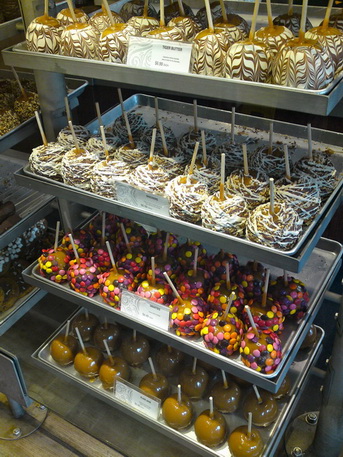
And then of course there is lifestyle. And while I was obviously not acclimated (a terrible Americanism that I can’t seem to shake) enough to appreciate or even vaguely comprehend this yet, Canadians of the Vancouver and Victoria variety seemed remarkably outdoorsy and active – something that South Africans like to claim for themselves, but I suspect not as many of them actually practice.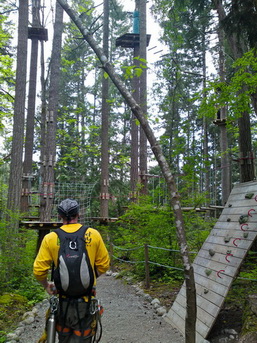
Be that as it may, most areas and cities in British Columbia are amazingly geared towards active lifestyles – from the running route around Stanley Park, to the numerous bicycle trails all around the city, and from the outdoor adventure courses in Nanaimo (picture above) to the availability of a multitude of water-sports like paddling, Dragon-boating and sailing – all of which is beyond me given the temperatures even though the barefoot mountain-guide tells me that because of currents and things the water there is actually warmer than Cape Town, but I’ll just be taking his word for that.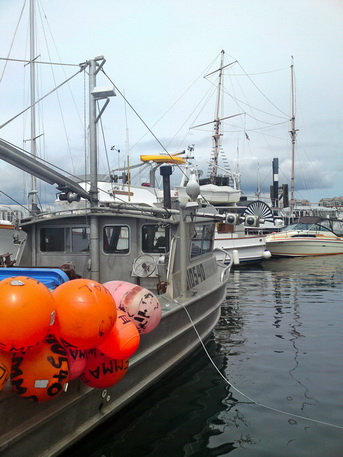
And then, unexpectedly would appear such an odd oddity that we’d do a double take – in some ways Canadia felt like a different planet entirely.
My much younger and much taller baby-brother and I once agreed that Canadians probably have the dubious honour of being the most naturally uncool people on the planet. No offence. But the term “terminally un-hip” seemed to fit. And while I did meet a couple of protégé rockstars (ahem), mostly I’m afraid this myth rang very true on my latest travels. But not always in the bad way you may think I’m implying – as with most things in life, there are pros and cons.
I think the “safeness” and naiveté of Canadians has much to do with the extremely safe, ordered, and middle-of-the-road culture that comes with long-term political stability, the relative safety and security of a Southern cousin that has the most power on the planet, and existing on a continent less politically rocky and culturally diversified than Africa. Hence the strikingly different idea of actually obeying traffic laws or waiting for the lights before you cross the street. South Africans smirk at such conformist behaviour, labeling law-abiding cultures “sissy” and “sheeplike”, and yet we complain about the crime at home incessantly. Makes you think, doesn’t it? (apologies to Nedbank).
And picking up on the cultural diversification idea – although Canadia is really extremely homogenous as a society (having treated the First Nations people abysmally in even recent times), I have it on good authority that approximately one third of Vancouverites (really) are now of Chinese descent. There is also a large and happy Indian influence, hence the many delicious curries (that’s “courie” in Canadia speak) enjoyed on our trip. So while they don’t have a patch on our eleven official languages and all the complexities that come with them, they are definitely dealing with difference and integration in their own way.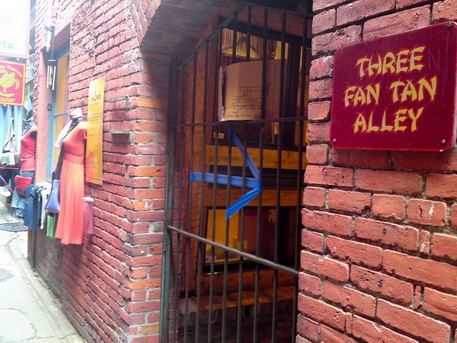
Green / Earth Friendly living is huge in Canadia. Well, at least in Vancouver and Victoria. Riding your bike, walking, using public transport – this is only the beginning. They also recycle, make compost, insulate their houses, and now they’re even building completely “off the grid” housing complexes – their own sewerage systems, water systems (they’re built on the river sensibly), and own energy generation. Absolutely brilliant. But not cheap. This is the first world, after all.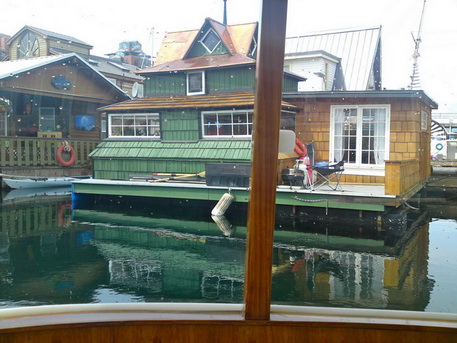
And speaking of houses, apart from the perennially fascinating floating houses in both Vancouver and Victoria, I would be remiss not to mention the equally fascinating idea of moving house in Canadia. And I don’t mean moving house as in packing all your stuff in endless boxes and moving to another house on another patch of land, I mean literally moving your house. In Canadia you can as easily pack up your house, hire a huge flatbed truck and have your entire house lifted from it’s foundation and moved to a new position, hopefully one with a better view. Or, if you didn’t like your house anymore but quite like the place it was sitting on, you could pick your house up and park it along one of the highways with a “For Sale” sign on. Seriously – I mean, could I make this stuff up? So in Canadia you can genuinely ask someone if their house has brake-lights or not, and not get a funny look.
And if you spent a few weeks in Canadia, you could also be asked if you had your “Toque (pronounced ‘took”) and mittens” packed in Whistler (beanie and gloves, in local lingo); or be offered Bubble Tea (basically fruit juice with tapioca in) and Beavers Tails (the most delicious deep-fried doughy cinnamon & sugar covered things ever) in Vancouver; or even have barbecued Bison burgers in Victoria – which we tried and which tasted more similar to ostrich than beef, being extremely lean and apparently extremely good for you. And it really is Bison, it’s not a euphemism for something else!
And of course, given the asian influences, you can also be served along with your toast and eggs, Dragonfruit for breakfast. A delicious white fleshed fruit with black seeds dotted all over that tastes very similar to Kiwi fruit. And then you will know you’ve been to Canadia.
All of which made me realise, again, that so much of what identity is, is shaped by difference.
In fact, about a year ago I read a quote in the Kulula in-flight magazine about living off the grid (no, the irony does not escape me) about uniqueness:
“A great deal of what makes us unique is rooted in the variety of ways we choose to deviate from social and cultural norms.”
– Article by Tanya Factor in Comic Life Magazine July 09.
And as many times as I’ve said this before, it still holds true! In the end, brands are really all just about differentiation.
A brand is nothing other than a set of choices with regards to what it will and won’t stand for. And the more different or unique it is, the greater it’s likelihood of surviving the wild ride of commercial branding.
So here are some uniquely Canadian inspired thoughts on differentiation.
1. Don’t be scared to differentiate even the mundane – the more different, the more memorable.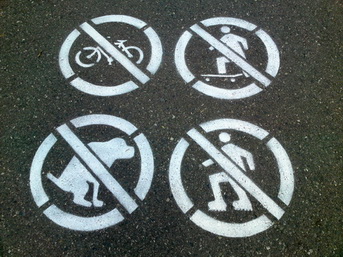
These signs all over Victoria amused me no-end. Anywhere else, the dog would have been standing with a waggy tail, but in Victoria they are specific about their bans – your dog is welcome as long he’s not shitty about it!
2. Differentiation is all about choice – don’t stand in the middle, pick a side and do it whole-heartedly otherwise you’ll just be average and forgotten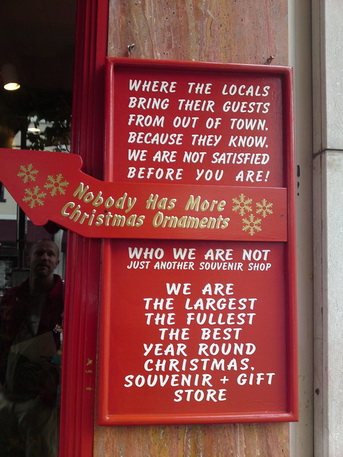
This store only sells Christmas ornaments. And it’s not a small store. And it is packed, literally to the ceiling with stuff. Now that is being serious about making your choices!
3. Be single-minded in your differentiation. Differentiation does not mean being something different to each person you see, it means being different to your competitive set or your peer group, and sticking to the guns you’ve chosen, come high noon or snow drifts.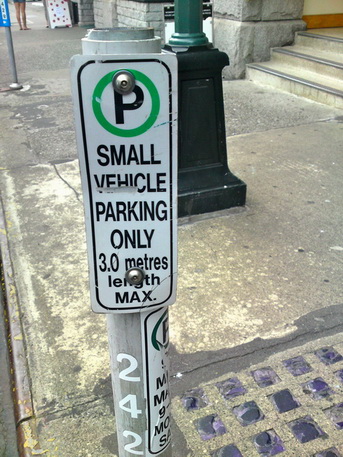
Victoria, for example, has decided to go green and do so with gusto. The mayor of the town has a Smart car as his mayoral vehicle, and they carry this ethos through to everything: bikes have right of way over bridges, pedestrians rule the road (this is true of the whole of Canadia I’m told, but still), and there are special prime parking slots for smaller, more earth-friendly cars in the city. Simple, clear and consistent in everything.
4. Be able to tell the story about your differentiation. Know what it stands for, where it comes from and why it matters. And tell people clearly.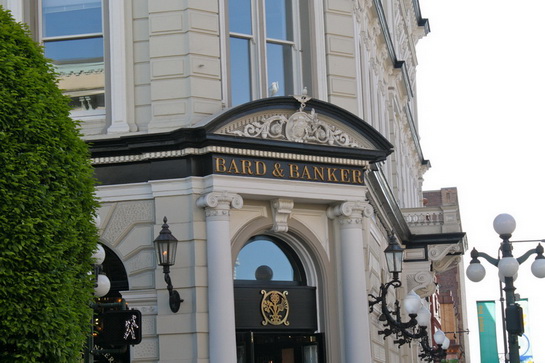
This pub in Victoria has a wonderful story: It is an old bank building, and one of it’s employees (a teller I believe, but I stand under correction), eventually became one of Canadia’s most popular and well-known poets. Inside they have a picture of the poet in his old Bank and they respectfully called the pub the “Bard & Banker” in his honour. And so the story of this brand is so unique, and so real and so memorable that it literally grabs hold of you and doesn’t let go. Ask me, I carried it all the way home with me.
5. Be real. Be as real as you can when you choose your differentiation story.
Today’s consumers know more, have more access to information and are more educated than ever before and it means that more and more they are looking for the “real” story behind the brand. Where we used to create stories for products and turn them into brands, we now look for stories in brands and products and present these real stories as differentiation.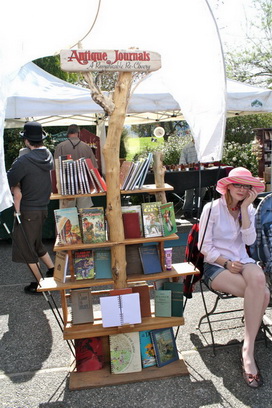
This delightful stand was at the Saturday fair in the village of Ganges on Salt Spring Island – a remarkable place with a unique differentiation story since the First Nations people kept this island as a healing island you visited when you need to, and it is now a very arty, green community. The market, for example, is only for Salt Spring local sellers who must make their wares themselves and must also sell them personally at the market. Nice and unique.
The stand sells journals made with covers that used to be the hard-covers to books and the selling line is very cleverly, and very uniquely “A Remarkable Re-Covery”. Lovely.
A perfect reminder that there really is no safer way to be unique than to own your own real story. After all, if your story is real and true, who could ever really copy you?
June 1st, 2010 at 1:36 pm
Existential crisis…! I love it, definitely got me giggling again.
Sounds like you had an amazing time. Can’t picture you enjoying a barbecued Bison burger though (hmmmm..!)
S x
June 3rd, 2010 at 9:48 pm
LOL, glad it made you giggle – I miss you girls!
Indeed – Bison burger was had, and now I can say so, but don’t think it’ll be on my “Favourite” list anytime soon!
August 27th, 2010 at 8:14 pm
[…] Dragonfruit for Breakfast | Branded Blog […]